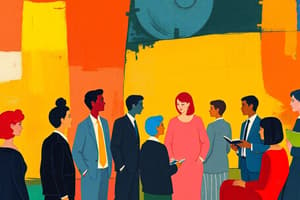Podcast
Questions and Answers
According to Kroeber and Kluckhohn (1952), culture consists of...
According to Kroeber and Kluckhohn (1952), culture consists of...
- Patterned ways of thinking, feeling, and reacting (correct)
- Invisible patterns of behavior
- Written laws and regulations
- Unpredictable and random behaviors
What does Schein (1992) define as organiza$onal culture?
What does Schein (1992) define as organiza$onal culture?
- Basic assumptions and beliefs shared by members of an organization (correct)
- Purely individual beliefs and thoughts
- Visible structures and processes within an organization
- Externally imposed rules and regulations
According to Bate (1996), is culture resistant to change?
According to Bate (1996), is culture resistant to change?
- Yes, it cannot be changed
- No, it is changing all the time (correct)
- It can only be changed through external interventions
- It depends on the size of the organization
What are the three perspectives identified for culture change?
What are the three perspectives identified for culture change?
What is the general agreement regarding achieving culture change?
What is the general agreement regarding achieving culture change?
What is single-loop learning also referred to as?
What is single-loop learning also referred to as?
According to Johnson (1990), what type of learning involves questioning the means as well as the goals themselves?
According to Johnson (1990), what type of learning involves questioning the means as well as the goals themselves?
What did Schwartz and Davis (1981) propose as a way of measuring culture?
What did Schwartz and Davis (1981) propose as a way of measuring culture?
What is a possible choice for management in dealing with cultural incompatibility with proposed strategic change?
What is a possible choice for management in dealing with cultural incompatibility with proposed strategic change?
What step relates to transforming a supply chain according to Halm (2014)?
What step relates to transforming a supply chain according to Halm (2014)?
What are the three levels of culture according to Schein?
What are the three levels of culture according to Schein?
Which of the following is NOT an element of the cultural web for revealing organizational cultures?
Which of the following is NOT an element of the cultural web for revealing organizational cultures?
According to the compass model of culture, what are the behavioral components that lead to different culture typologies?
According to the compass model of culture, what are the behavioral components that lead to different culture typologies?
Which tool is used for revealing organizational cultures and consists of artifacts, shared basic assumptions, values, and beliefs?
Which tool is used for revealing organizational cultures and consists of artifacts, shared basic assumptions, values, and beliefs?
How can cultural change be facilitated according to the text?
How can cultural change be facilitated according to the text?
Which organizational culture type operates through logic and rules, emphasizing defined roles and is least conducive to change?
Which organizational culture type operates through logic and rules, emphasizing defined roles and is least conducive to change?
Which culture type focuses on project work, devolves decision making to projects, and thrives in creative environments?
Which culture type focuses on project work, devolves decision making to projects, and thrives in creative environments?
Which typology of culture, strategy, and environment includes tough-guy, macho, work-hard/play-hard, bet-your-company, and process cultures?
Which typology of culture, strategy, and environment includes tough-guy, macho, work-hard/play-hard, bet-your-company, and process cultures?
Which culture type invests heavily in long-term projects and has top-down decision making?
Which culture type invests heavily in long-term projects and has top-down decision making?
Which dimension did Scholz add to bring culture and environment together?
Which dimension did Scholz add to bring culture and environment together?
Study Notes
- Charles Handy identified four organizational culture types: power, role, task, and person.
- Power cultures have a single dominant person or group, centralized decision making, and decisions based on influence.
- Role cultures operate through logic and rules, emphasize defined roles, and are least conducive to change.
- Task cultures focus on project work, devolve decision making to projects, and thrive in creative environments.
- Person cultures exist to serve members and have minimal structures.
- Deal and Kennedy proposed a typology of culture, strategy, and environment, including tough-guy, macho, work-hard/play-hard, bet-your-company, and process cultures.
- Tough-guy cultures have high risks, focus on speed, and have high turnover.
- Work-hard/play-hard cultures emphasize the team and have low risk.
- Bet-your-company cultures invest heavily in long-term projects and have top-down decision making.
- Process cultures focus on technical perfection and are effective in stable environments.
- Scholz added three dimensions to bring culture and environment together: external-induced, internal-induced, and evolution-induced.
- Five culture types emerged: stable, reactive, anticipating, exploring, and creative.
- Segmentalist cultures compartmentalize problems and have weak coordinating mechanisms.
- Integrative cultures combine ideas from unconnected sources, encourage differences, and are outward looking.
- Single-loop learning assumes goals are fixed and only considers ways to reach those goals.
Studying That Suits You
Use AI to generate personalized quizzes and flashcards to suit your learning preferences.
Related Documents
Description
Learn about the four organizational culture types proposed by Charles Handy in 1993. Understand the characteristics of power culture and its impact on decision making within an organization.




